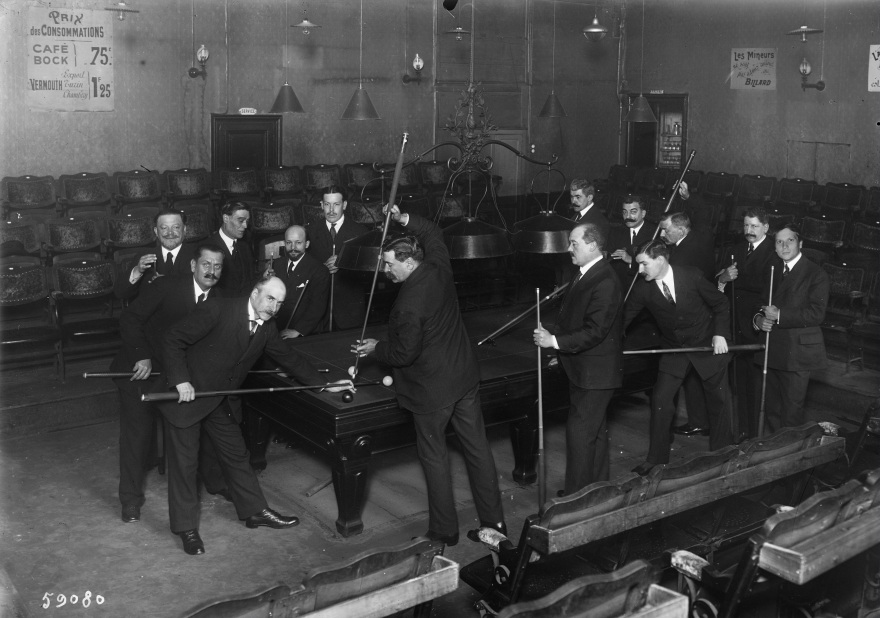Balkline is the overarching title of a large array of carom billiards games generally played with two cue balls and a third, red object ball, on a cloth-covered, 5 foot × 10 foot, pocketless table that is divided by balklines on the cloth into marked regions called balk spaces. Such balk spaces define areas of the table surface in which a player may only score up to a threshold number of points while the object balls are within that region.
The balkline games developed to make the precursor game, straight rail, more difficult to play and less tedious for spectators to view in light of extraordinary skill developments which allowed top players to score a seemingly endless series of points with the balls barely moving in a confined area of the table playing area. Straight rail, unlike the balkline games, had no balk space restrictions, although one was later added. The object of the game is simple: one point, called a “count“, is scored each time a player’s cue ball makes contact with both object balls (the second cue ball and the third ball) on a single stroke. A win is achieved by reaching an agreed upon number of counts.
Carom billiards players of the modern era may find it surprising that balkline ever became necessary given the considerable difficulty of straight rail. Nevertheless, according to Mike Shamos, curator of the U.S. Billiard Archive, “the skill of dedicated players [of straight rail] was so great that they could essentially score at will.” The story of straight rail and of the balkline games are thoroughly intertwined and encompass a long and rich history, characterized by an astounding series of back and forth developments, akin to a billiards evolutionary arms race, where new rules would be implemented to make the game more difficult and to decrease high runs to keep spectators interested, countered by new shot inventions and skills interdicting each new rule.
Faroux was one of the best French carom billiards players in the 1900-1920s. In 1905, he competed in his first world carom billiards championships, and at the 1907 event reached second place, which he accomplished again in 1910. In 1912 and 1919, he won the world championship title in this discipline. Since his motorsport interest often overlapped with the carom billiards interest, producing scheduling conflicts, he said in April 1926 that he would play in the world championships rather than the Targa Florio. In 1927, he competed in his last world championship, winning that event, and afterwards devoted all of his time to motorsport
Balklines did not stop the rail nurse but they did restrict its use. Soon a new type of nurse was developed which exploited a loophole in balkline rules: so long as both object balls straddled a balkline, there was no restriction on counts, as each ball lay in a separate balk space. The new technique, deemed the anchor nurse, again increased runs greatly. The anchor nurse is a stationary shot in which both object balls, falling on either side of a balkline, are hit repeatedly without moving—they are “anchored” in place. Once again a new rule was necessary to combat this new skill development; thus arose the Parker’s box in 1894.
Named after Chicagoan J. E. Parker, the tournament director who suggested it after Jacob Schaefer, Sr. and Frank C. Ives both posted extensive runs at his room using the anchor nurse, the Parker’s box is a rectangular marking straddling the spot where the balkline meets each rail. Enclosing a space 3.5 inches (8.9 cm) out from the rail and 7 inches (18 cm) across, the box marks a region where both balls are considered in balk, despite that the object balls may technically fall on either side of a balkline. When first instituted, ten shots were allowed while the balls were inside the Parker’s box or “in anchor”. This was reduced to five in 1896 when 18.2 balkline was gaining popularity.
True to form, the next skill development response was the chuck nurse, known as a rocking cannon in the United Kingdom. With one ball frozen to the cushion in the Parker’s box, but the second object ball away from the rail just outside the borders of the Parker’s box, the cue ball is gently rebounded off the frozen ball not moving it, but with just enough speed to meet the other object ball which rocks in place, but does not change position. In 1912, playing 18.2 balkline, William A. Spinks ran 1,010 continuous points using the chuck nurse and broke off his run without ever missing.
There were a number of proposals to curtail the chuck nurse’s effectiveness, including removing the four balk spaces on the end rails where dominant players in the 1920s such as Willie Hoppe, Welker Cochran and Jake Schaefer Jr, (Jacob Sr.’s son) had perfected their nursing skills, but leaving balk spaces in place on the long rails.
